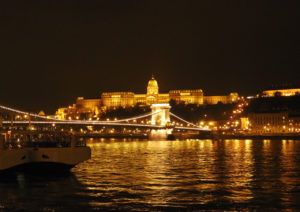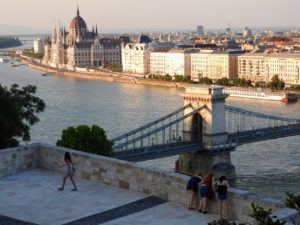Historical Bridges over the Danube in Budapest
The River Danube is more than just a scenic backdrop in Budapest—it’s the very heart of the city, gracefully dividing the hilly Buda side from the flat, vibrant Pest side. Once two separate towns, Buda and Pest were unified in 1873, and today, they are seamlessly connected by a series of 12 bridges. These crossings are not just functional; they are architectural gems that give Budapest its unmistakable charm and character. Among them, a few historical bridges stand out not only for their age but also for their stories, symbolism, and beauty. These structures are as much a part of Budapest’s identity as the Parliament Building or Buda Castle. Whether you’re strolling across them on a quiet evening or admiring them illuminated at night, these bridges offer some of the city’s most memorable views. Let us take you through the top three most iconic and historically significant bridges that span the Danube in Budapest—you may find they’re more than just ways to get from one side to the other.
Chain Bridge – Budapest Danube

Chain Bridge (Széchenyi Lánchíd): The First Permanent Link Between Buda and Pest
The Chain Bridge, completed in 1849, was the very first permanent bridge to span the River Danube in Budapest, forever linking the hilly Buda side with the flat, bustling Pest. Before its construction, the only connection was a seasonal pontoon bridge, available only from spring to autumn. In winter or during floods, crossing the river was often impossible—causing major delays for commerce, governance, and personal travel.
One of the most often-cited turning points came in the 1820s when Count István Széchenyi, one of Hungary’s greatest statesmen, was stranded on the Buda side during a flood and missed his father’s funeral on the Pest side. This personal loss became symbolic of a broader national issue and fuelled Széchenyi’s determination to modernise Hungary’s infrastructure—beginning with a permanent bridge across the Danube.
Hungarian engineers at the time lacked experience with large-scale suspension bridges, and many feared the risks involved: unstable riverbeds, potential collapses, flooding, and dangerous drift ice. Undeterred, Széchenyi partnered with wealthy Viennese banker György Sina (Georgios Sinas, Austrian – Greek entrepreneur) to fund the project (you can see his coat of arms on the bridge). Together, they commissioned the distinguished English engineer William Tierney Clark, who had earlier designed the first suspension bridge over the River Thames in London (Hammersmith Bridge).
The foundation stone of the Chain Bridge was ceremonially laid on August 24, 1842, by Archduke Joseph, the Palatine of Hungary, in the presence of dignitaries and great anticipation. The bridge was finally completed in 1849, during a tumultuous time in Hungary’s history, just after the defeat of the Hungarian Revolution of 1848–49. Despite the conflict, the Chain Bridge became a powerful symbol of national progress and unity.
Today, the Chain Bridge remains one of Budapest’s most iconic landmarks—a majestic example of 19th-century engineering and a monument to Széchenyi’s vision of a modern, connected Hungary.

Chain Bridge – Survived Revolutions, War, and Time
The Chain Bridge was a true international effort—designed in Britain, built in sections, and shipped to Hungary for final construction. At the time, its central span of 202 metres (663 feet) made it one of the longest suspension bridges in the world.
In 1848, during construction, part of the structure gave way, throwing Count Széchenyi and several workers into the Danube. Széchenyi survived by swimming to shore, but sadly, one worker lost his life. That same year, the Hungarian Revolution broke out, bringing construction to a halt.
After the revolution’s defeat, Austria took control, and the bridge was completed under their supervision. It was officially opened on November 20, 1849, by General Haynau—the same general known for brutally suppressing the Hungarian uprising. Ironically, the bridge had been a dream of Hungary’s national hero, Count Széchenyi, who by then was too unwell to attend the ceremony. He spent the rest of his life in a mental health clinic in Döbling, near Vienna.
In 1852, the now-iconic stone lions were added to both ends of the bridge, sculpted by János Marschalkó. When Buda, Pest, and Óbuda united in 1873 to form the capital city of Budapest, the Chain Bridge became the symbol of that unity.
During World War II, retreating German troops blew up all of Budapest’s bridges—including the Chain Bridge. It was rebuilt and triumphantly reopened in 1949, exactly 100 years after its first inauguration. Since then, it has undergone several renovations, the most recent beginning in the 2020s, ensuring it remains a proud emblem of Budapest for generations to come.
Margaret Bridge – Budapest Danube

Margaret Bridge (Margit híd): A Graceful Curve Across the Danube
Margaret Bridge was the second permanent bridge to be built in Budapest, linking St. Stephen’s Boulevard (Szent István körút) on the Pest side with Margit Boulevard (Margit körút) in Buda—while elegantly touching the southern tip of Margaret Island. Construction took place between 1872 and 1876, and the bridge was officially inaugurated on April 30, 1876.
At first, building a second bridge wasn’t so simple. The Chain Bridge, opened in 1849, held an exclusive monopoly: no new bridge was allowed within 8 kilometres in either direction, to protect its private revenue. But as Budapest’s traffic grew and the city expanded, the authorities decided to buy back the rights and move forward with a much-needed second crossing.
A design competition was held in 1871, and the winning proposal came from renowned French engineer Ernest Gouin. His firm, the Société de Construction des Batignolles in Paris, led the project. Like the Chain Bridge, Margaret Bridge was a European collaboration—the iron components were manufactured in France and transported to Hungary by train.
One of the bridge’s most striking features is its unusual 165-degree angle, forming a soft V-shape at the point where it branches onto Margaret Island. This unique bend makes the bridge instantly recognisable and functionally important: before a connecting spur was added in 1900, the island could only be reached by boat.
Adding to its elegance, the bridge’s piers are decorated with bronze galley prow figureheads—winged female forms—sculpted by Adolphe Martial Thabard, a French artist. The central section includes a plaque with the Hungarian Crown, flanked by two obelisks commemorating the bridge’s construction.
At 607.6 metres, Margaret Bridge is not only practical but a graceful piece of architecture. However, its history also includes tragedy. During World War II, the bridge was destroyed twice. The first explosion, a tragic accident in November 1944 during rush hour, killed approximately 600 civilians when a gas leak ignited. The second, in January 1945, was deliberate—German forces retreating from Budapest blew up the remaining sections.
Since the war, Margaret Bridge has been faithfully restored and renovated several times, most recently in the 2000s. Today, it stands as a key crossing and one of the city’s most beautiful—and distinctive—bridges.
Liberty Bridge – Budapest Danube

Liberty Bridge (Szabadság híd): The Smallest, Yet Most Beloved Bridge in Budapest
Connecting Fővám Square on the Pest side with Gellért Square at the foot of Gellért Hill in Buda, Liberty Bridge is the third-oldest—and the smallest—bridge in Budapest. Measuring just 333 metres long and 20 metres wide, it may be compact, but it holds a special place in the hearts of locals and visitors alike.
Following the financial success of the Chain Bridge and Margaret Bridge, Hungarian law required that a third bridge be built to meet the city’s growing needs. The Ministry of Commerce launched an international tender for its design. Although there were many foreign applicants, the winner was a Hungarian engineer, János Feketeházy. The architectural design was prepared by Virgil Nagy, and construction began in 1894.
Resting on just two massive pillars, the bridge was considered a cutting-edge engineering achievement of its time. Its elegant structure is adorned with decorative Parisian-style lampposts, four ornate spires, and statues of the Turul bird—a mythological hawk-like creature that symbolises power and protection in Hungarian folklore. Crowning the central elements is the Hungarian Holy Crown.
Originally painted green and known as the Franz Joseph Bridge, it was named after the Austro-Hungarian Emperor, who ceremonially inserted the last silver rivet himself at the grand inauguration on October 4, 1896, marking the Millennium celebrations of the Hungarian state.
Sadly, like Budapest’s other bridges, Liberty Bridge was blown up by retreating German forces in January 1945 during World War II. The destruction was devastating—but temporary. Within weeks, a makeshift pontoon bridge was erected, and soon after, repairs on Liberty Bridge began in earnest.
Today, Liberty Bridge is much more than a river crossing. It has become one of the most photographed landmarks in Budapest and a favourite hangout for locals. In recent years, it has even been closed to cars on some summer weekends to host open-air concerts, picnics, yoga classes, and the popular Liberty Bridge Takeover events—giving the historic structure a fresh, youthful energy.
Whether admired from the banks of the Danube or enjoyed up close under the sun, Liberty Bridge is a true Budapest icon—compact, charming, and full of character.

